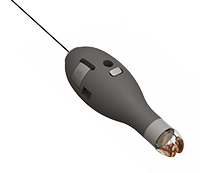Benthic species can remain stationary for days, making it difficult to deduce mortality from our typical data sets—depth, temperature, and light. The Benthic sPAT adds tilt to help measure activity (or inactivity) in order to help determine mortality.
Like our other pop-up satellite tags, sensors collect data during deployment and archive it onboard the tag. Then, on a preset date, the tag releases from its host animal, surfaces, and uploads a summary of the archived data to the Argos satellites. The Wildlife Computers Benthic sPAT tags work on species like halibut, sole, flounder, turbot, and rays.

It’s All About the Data
The Benthic sPAT is attached using a single-point tether that allows it to tilt over (knockdown) when the animal swims in a burst. While stationary, the tag is vertical and the accelerometer is reporting “upright” but when the animal swims, there is a change in acceleration that causes the tag to “knock down.” This
creates a very noticeable signal in just the Az accelerometer channel.
The user selects the threshold that qualifies a change in acceleration as a knockdown event. The user also selects a threshold definition of upright to determine the amount of time a tag spends upright versus tilted.
For each UTC day, one orientation message is generated that contains two-hour summary periods with the following information:
- Time upright
- Number of times the tag was knocked down
- Wet/dry summary
Benthic sPATs can release on a date, interval, or if the tag detects it is at the surface and reading dry, indicating the tether has broken or has become detached from the fish.
Available Data Products
- Wet (0-1) Archive
- Acceleration 3-Axis Archive
- Knockdowns Archive
- Argos Locations
- Orientation
Key Features
Economical Monitoring of Animal Survivorship—most survivorship studies require a large sample size to be statistically significant. Built for a single purpose, the sPAT offers a larger number of data points for your budget.
Full Data Archive Available on Recovery—a complete data record is stored onboard the tag so if you recover it, you can access it.
The Portal Advantage—sPAT tags are supported by the Wildlife Computers Data Portal, a collection of data management tools and services. Developed specifically for the display and investigation of data from Wildlife Computers tags, the data portal streamlines the processes of acquiring, preserving, and sharing data services. The portal helps collect, prepare, and analyze the data returned from the tag—via Argos or the archive. Data are easily sorted, filtered, searched, uploaded, and shared. You can see a Google Earth display of your deployment track, color-coded to show the relative age of each location. You can also set up a live KMZ to get data into your own monitoring system.
User Guide/Software
This user guide gives you all the essential information needed for interacting with, configuring, and deploying this tag. It also includes instructions on how to use Tag Agent.
USB Communications Cable Driver – 29-March 2023
Driver for the Wildlife Computers USB Communications cable.
Specifications
Below are the physical specifications of the Benthic sPAT. A full description of these features is available on the downloadable Benthic sPAT Product Features (PDF).
| Dimensions | 118 mm (length) x 38 mm (diameter) |
| Weight in Air | 60 grams |
| Pressure Rating | 2000 m |
| Memory | 64 MB |
| Operating Frequency | 401.678 MHz |
| Operating Life | Up to 96 days |
| Sensors | Wet/Dry, Acceleration |
| Accelerometer Range | ± 2 g |
| Accelerometer Resolution | 4 mg |
| Accelerometer Accuracy | ± 0.15 g |
| Conductivity Operational Limits | 0.1 to 5 S/m |
| Optimal Storage Temperature Range (°C) | 0° C to 5° C |
| Communication | Via USB port using Wildlife Computers USB communications cable |
